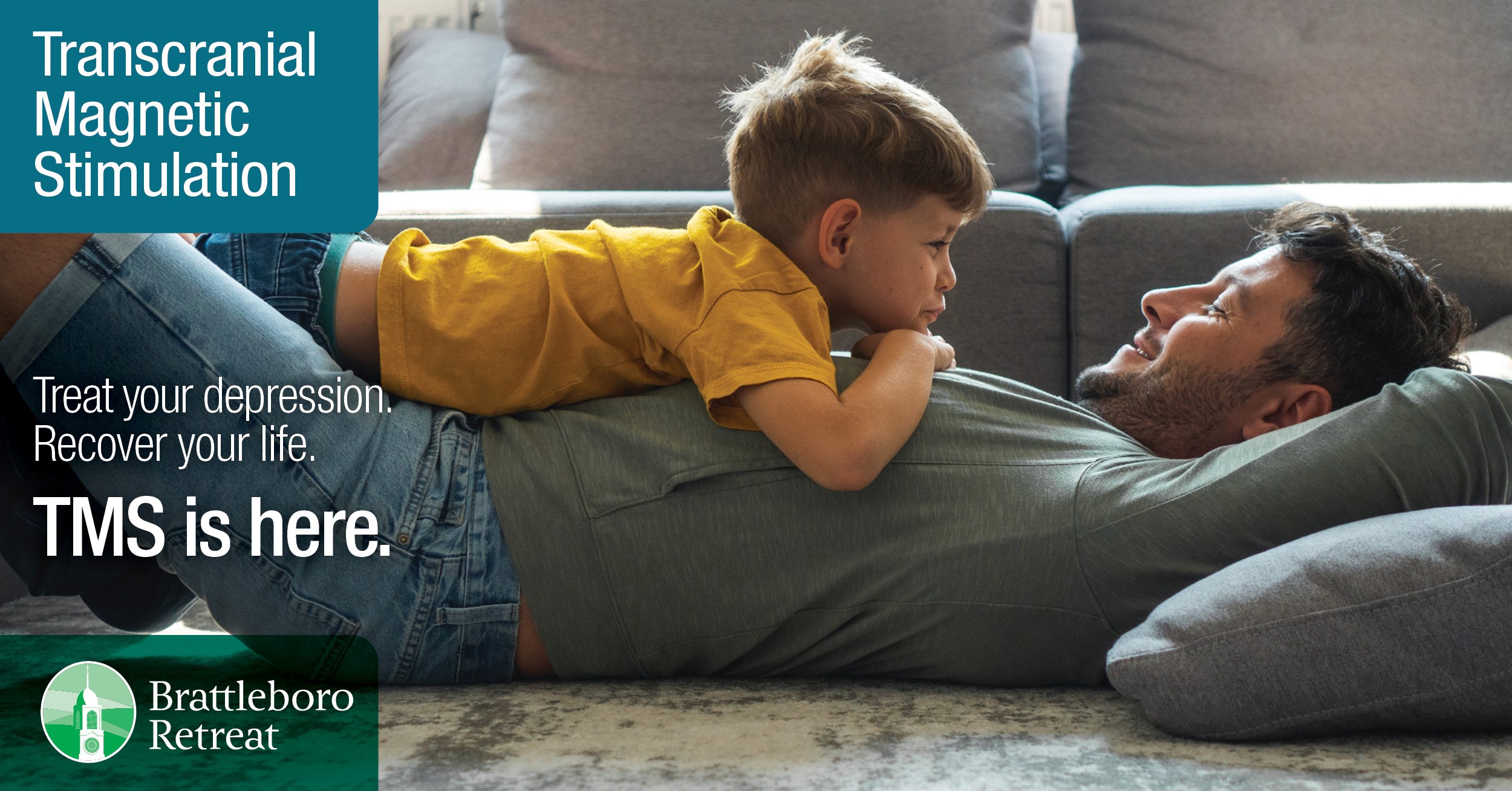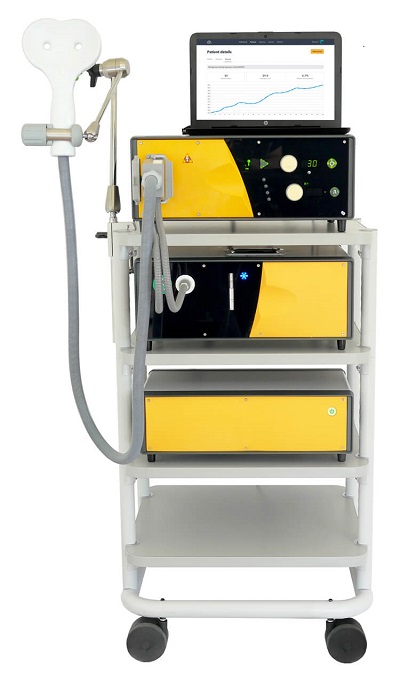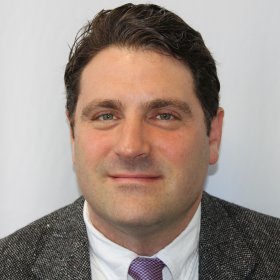When antidepressants fall short for you, TMS can break through.
For people with treatment-resistant depression, transcranial magnetic
stimulation (TMS) at the Brattleboro Retreat offers a safe alternative.

What You Should Know About TMS
TMS (transcranial magnetic stimulation) is an FDA approved treatment for people with major depressive disorder (MDD) that have not had lasting relief with first-line treatments like antidepressants and psychotherapy. TMS is a type of noninvasive brain stimulation that applies electrical pulses to the brain using a magnetic coil placed over the head. When electromagnetic pulses are targeted at a specific region of the brain that is either underactive or overactive in those with MDD, new neural pathways are stimulated. When done repetitively over a 6 week period, TMS can strengthen these newly formed connections between brain cells. Increased connectivity between brain cells helps to improve overall brain function and mood.
TMS is safe, well-tolerated and noninvasive. TMS was FDA-approved in 2008 as a treatment for MDD, and more recently as a treatment for obsessive compulsive disorder. Clinical studies have researched long-term TMS risks, and data continues to support its efficacy and safety. TMS does not negatively impact cognition or memory.
There are minimal risks associated with TMS. Seizures are considered the most serious risk, yet the incidence of seizure is incredibly low. Currently, the estimated risk of seizure is 1 in 30,000 treatments. Although seizures are very rare, it is important for patients to inform the TMS technician of any changes in health, medications, drug or alcohol use, and/or disruptions in sleep since the previous treatment session. In these situations, the tech may contact the doctor on-site to get confirmation that it is safe to continue with the next treatment.
Patients who have been approved for TMS have already been assessed for any contraindications, like seizure history and metal in the head. However, since the treatment uses a magnet, it’s important to remove glasses, jewelry and other magnetic objects worn on the head to prevent interactions with the magnetic field.
The possible side effects of TMS are minor and temporary. The most common side effect is a mild headache, and it usually subsides after several treatments. Some patients experience scalp pain early in treatment due to the contraction of muscles in the scalp caused by the magnetic field, but this often diminishes over the course of treatment. Facial tingling or twitching may occur due to stimulation of the facial nerve, but any discomfort can immediately be reduced by adjusting the coil position and the stimulation settings. It is important to report any persistent or worsening side effects in the event that TMS may not be suitable for the patient.
Video by CloudTMS
Dr. Rustin Berlow of the American Brain Stimulation Clinic
TMS is painless for the majority of patients. Once the technician places the coil against your head and starts the treatment, you’ll hear a clicking sound and feel a tapping sensation on your head. Due to the fact that TMS generates a loud clicking sound with each pulse, patients are advised to wear earplugs for hearing protection. Earplugs will be provided during the sessions.
Video by CloudTMS
Dr. Rustin Berlow of the American Brain Stimulation Clinic
TMS is prescribed by a licensed medical doctor. All psychiatrists that prescribe TMS at the Brattleboro Retreat are TMS credentialed. The treatments will be administered by a TMS technician under the supervision of an MD. Treatments can be stopped at any time if the patient requests and there will always be a technician or doctor present for safety and monitoring.
After a thorough consultation with an MD, patients will schedule their first treatment. Before receiving TMS, the doctor will need to take a few measurements. Head measurements (cortical mapping) will be taken to determine where the coil will be placed so that the treatment can be as targeted as possible to the part of the brain that isn’t functioning optimally. After, the doctor will need to determine the patient’s motor threshold (MT). MT is the lowest stimulation needed to cause the thumb to move. Knowing a patient’s MT allows for the treatment dose to be specific to that individual. Once cortical mapping is complete and MT has been determined, the doctor or technician will administer the patient’s first treatment. The session takes place while the patient is positioned as comfortably as possible in the TMS chair, with the magnetic coil placed and secured gently on the head.
Sessions typically occur five days a week, Monday through Friday, for up to six weeks. After six weeks, there will be a three week tapering period where the patient has 6 additional TMS treatments. The duration of each session is dependent on the specific protocol used, but generally lasts 3-19 minutes. After the initial TMS appointment, expect most appointments to last approximately 30 minutes to allow time for checking in with the technician and discussing any changes that may have occurred since the previous session.
Other than the time commitment of making it to scheduled appointments Monday through Friday, TMS causes minimal disruption to daily living. TMS allows for patients to drive themselves to and from their appointments and to go about their daily routines after each treatment.
Most patients start to notice the benefits of TMS treatment within 14-20 sessions. Some patients are “late responders” and don’t experience positive results until after the treatment series is complete. Research has shown that approximately 50% of patients will experience an improvement in symptoms, while approximately 30% will experience complete remission.
Video by CloudTMS
Dr. Rustin Berlow of the American Brain Stimulation Clinic
Similar to TMS, ECT (electroconvulsive therapy) is a treatment most commonly used in patients with treatment resistant depression. Unlike TMS, ECT involves inducing a seizure while the patient is under general anesthesia and unconscious, which can require hospitalization. TMS does not involve inducing seizures. Anesthesia is not used in TMS and the patient is conscious for the duration of treatment.
Video by CloudTMS
Dr. Rustin Berlow of the American Brain Stimulation Clinic
The Retreat’s referral and admissions process is designed to be simple and convenient. For more information call 802-258-3700.




